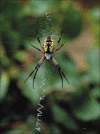Evolution of sexuality: biology and behavior
- PMID: 16200180
- PMCID: PMC1200732
- DOI: 10.1080/08998280.2005.11928075
Evolution of sexuality: biology and behavior
Abstract
Sexual reproduction in animals and plants is far more prevalent than asexual reproduction, and there is no dearth of hypotheses attempting to explain why. Even bacteria and viruses, which reproduce by cloning, engage in promiscuous horizontal gene exchange ("parasexual reproduction") on such short time scales that they evolve genotypic diversity even more rapidly than eukaryotes. (We confront this daily in the form of antimicrobial resistance.) The host-parasite and host-pathogen arms race purports to explain the prevalence of sexual reproduction, yet there are over a dozen other hypotheses, including the proposition that sexual reproduction purges the genome of deleterious mutations. An equally daunting challenge is to understand, in terms of evolutionary logic, the jungle of diverse courtship and mating strategies that we find in nature. The phenotypic plasticity of sex determination in animals suggests that the central nervous system and reproductive tract may not reach the same endpoint on the continuum between our stereotypic male and female extremes. Why are there only two kinds of gametes in most eukaryotes? Why are most flowering plants, and few animals, hermaphroditic? Why do male animals compete more for access to females than the other way around in most animals that have been studied?This review presents more questions than answers, but an extraordinary wealth of data has been collected, and new genetic techniques will provide new answers. The possible relevance of these data to human sexuality will be discussed in a future article.
Figures

















Similar articles
-
[Informative predation: Towards a new species concept].C R Biol. 2018 Apr;341(4):209-218. doi: 10.1016/j.crvi.2018.02.004. Epub 2018 Mar 30. C R Biol. 2018. PMID: 29606595 French.
-
On sexual behavior and sex-role reversal.J Psychosom Obstet Gynaecol. 2005 Sep;26(3):217-23. doi: 10.1080/01674820500170000. J Psychosom Obstet Gynaecol. 2005. PMID: 16295520
-
A perspective on the importance of reproductive mode in astrobiology.Astrobiology. 2003 Winter;3(4):657-71. doi: 10.1089/153110703322735999. Astrobiology. 2003. PMID: 14987472 Review.
-
Neurogenetics of courtship and mating in Drosophila.Adv Genet. 2008;62:67-184. doi: 10.1016/S0065-2660(08)00603-2. Adv Genet. 2008. PMID: 19010254 Review.
-
Reproductive versatility and the epigenetic control of female gametogenesis.Cold Spring Harb Symp Quant Biol. 2012;77:17-21. doi: 10.1101/sqb.2012.77.014894. Epub 2012 Dec 18. Cold Spring Harb Symp Quant Biol. 2012. PMID: 23250990 Review.
Cited by
-
Gene expression and alternative splicing dynamics are perturbed in female head transcriptomes following heterospecific copulation.BMC Genomics. 2021 May 18;22(1):359. doi: 10.1186/s12864-021-07669-0. BMC Genomics. 2021. PMID: 34006224 Free PMC article.
-
Uniparental nuclear inheritance following bisexual mating in fungi.Elife. 2021 Aug 2;10:e66234. doi: 10.7554/eLife.66234. Elife. 2021. PMID: 34338631 Free PMC article.
-
Paternal alcohol consumption has intergenerational consequences in male offspring.J Assist Reprod Genet. 2022 Feb;39(2):441-459. doi: 10.1007/s10815-021-02373-0. Epub 2022 Mar 21. J Assist Reprod Genet. 2022. PMID: 35307778 Free PMC article.
-
Sex determination and maintenance: the role of DMRT1 and FOXL2.Asian J Androl. 2017 Nov-Dec;19(6):619-624. doi: 10.4103/1008-682X.194420. Asian J Androl. 2017. PMID: 28091399 Free PMC article. Review.
-
Parthenogenetic Females of the Stick Insect Clitarchus hookeri Maintain Sexual Traits.Insects. 2019 Jul 10;10(7):202. doi: 10.3390/insects10070202. Insects. 2019. PMID: 31295894 Free PMC article.
References
-
- Fatouros NE, Huigens ME, van Loon JJA, Dicke M, Hilker M. Chemical communication: butterfly anti-aphrodisiac lures parasitic wasps. Nature. 2005:433–704. - PubMed
-
- Hrdy SB. Mother Nature: A History of Mothers, Infants, and Natural Selection. New York: Pantheon Books; 1999. - PubMed
-
- Hanlon RT, Naud MJ, Shaw PW, Havenhand JN. Behavioural ecology: transient sexual mimicry leads to fertilization. Nature. 2005:433–212. - PubMed
-
- Buston P. Social hierarchies: size and growth modification in clownfish. Nature. 2003;424:145–146. - PubMed
LinkOut - more resources
Full Text Sources
